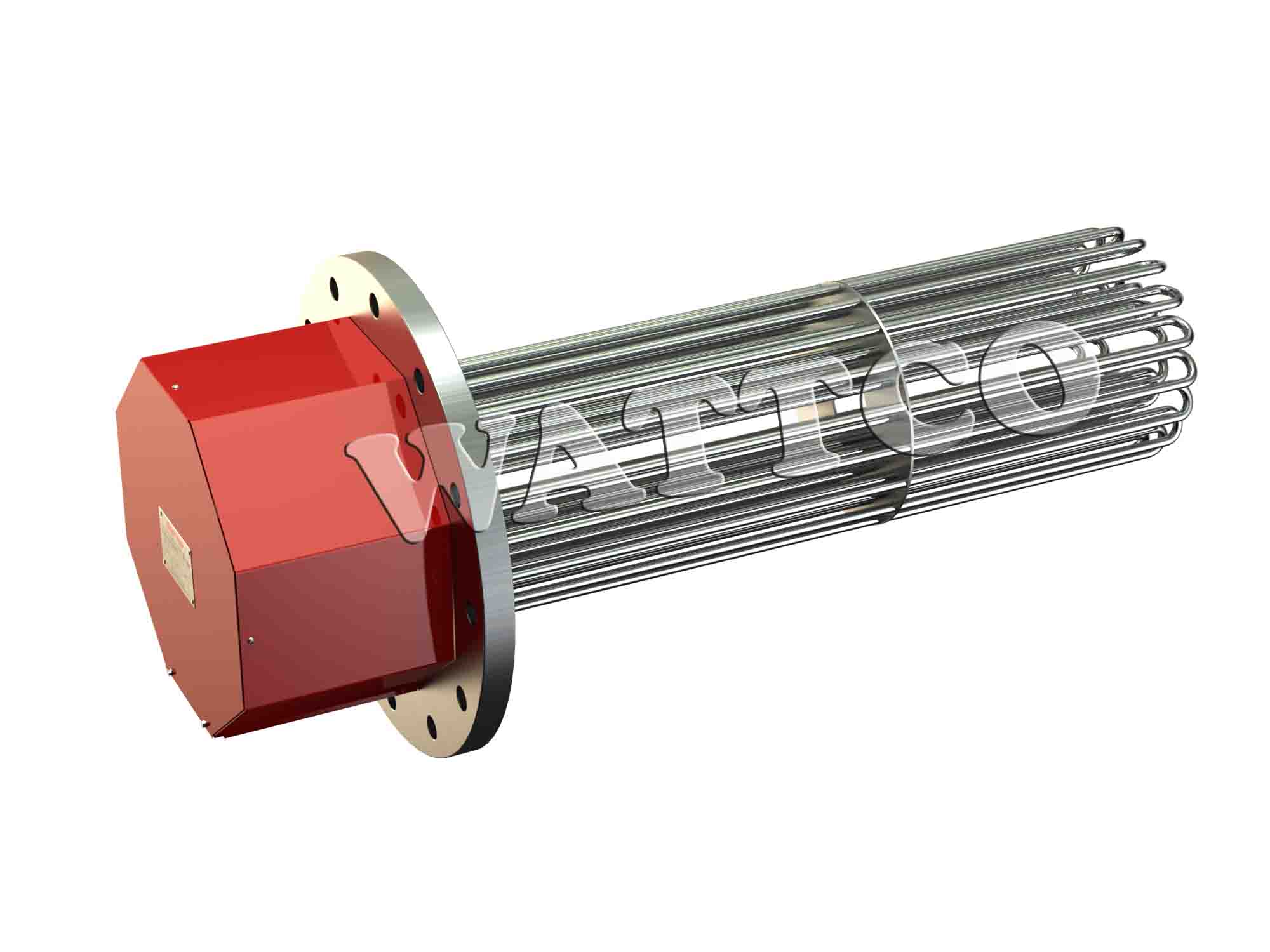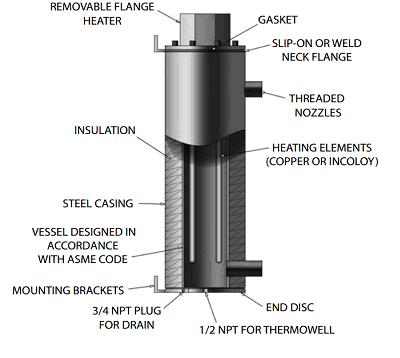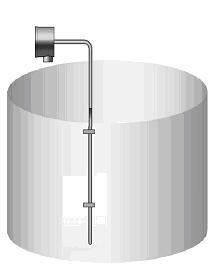Immersion Heaters
Last updated on January 9th, 2023 at 08:18 pm
Electric immersion heaters can be used for many industrial applications at various scale size. An immersion heater is a quick way to increase the target liquid or gas temperature. They are also efficient to use in the petrochemical industry. The applications of an immersion heater range from the extracted crude oil storage to the intermediate process heating in a petrochemical refinery facility.
There are different types and configurations of immersion heater that can be used in petroleum refining processes; however they all possess a common important part: the heater elements. A heater (or heating) element is a metallic tube that is used to heat the liquid or gas via direct contact heating. Each heating element possesses a metallic sheath material tube which encloses a Nickel Chromium resistor wire surrounded by Magnesium Oxide powders. The heater element tubes are bended and annealed to maximize the heat transfer efficiency and to fit the target application such as for oil storage tank heating.
A popular selection of WATTCO™’s electric immersion heater includes the flange immersion heater. This type of electric heater consists of a heating element tube bundle that is attached to a steel flange which is used for electrical source assembly and temperature control (See Figure 1). A flange immersion heater is the best choice for heating viscous liquid container such as a large crude oil storage tank. In the refinery process, the crude oil must be heated prior the fractional distillation for product separation. The pre-heating process is generally done by a large furnace at a high temperature of approximately 370 to 425°C. Before sending the crude oil to the furnace unit, the oil temperature must be high enough so that its viscosity would not lower the oil processing flow rate. A delay in moving the crude oil from the tank will eventually cause the refining process to have a longer process lead time. This problem can be solved easily by using heating elements for crude oil pre-heating. The tube length and shape of the flange immersion heater are selected based on the desired application.

Figure 1 – Illustration of a Flange Heater for Light Oil Application
What are Circulation heaters? Another variation of the immersion heater is the circulation heater (in line heater) which consists of a flange heater enclosed in a cylindrical casing (Figure 2). The unique feature of this heater is the capability of heating flowing and processing liquids. A circulation heater is designed to maintain the flow rate of the incoming liquid or gas while providing the necessary heat by the heating elements. The circulation heater can be used for intermediate processes in the refinery that require a rapid and precise temperature increase of the processing liquid. The heater elements are not limited to processing oil use only but also with various liquids such as water. In addition, the circulation heater is perfect to use for waste oil heating. Waste oil is a by-product produced either during the refinery process or from the environment. This by-product oil has lost its original function and value. However, instead of disposing the waste oil into the environment, it can be re-refined and mixed to produce valuable products and save unnecessary disposal expenses. Special materials can be considered for corrosive liquids heating.

Figure 2 – Components of a Circulation Heater
Figure 2 – Components of a Circulation Heater
Over-the-side immersion heater can be used for heating smaller size liquid tanks. An illustration of a particular shape of an over-the-side immersion heater is shown on Figure 3. A unique feature of this immersion heater is that the side wall of the liquid tank does not require an opening for heater insertion. The heater elements can be inserted to the system simply by a top inlet of the tank (such as a nozzle). The over-the-side heater is particularly efficient for precise heat control despite its smaller size. Unlike the other immersion heaters, the over-the-side heater does not require to completely empty the liquid tank before the heater removal. An example application of an over-the-side heater includes the pre-heating of liquid tank, under cold ambient environment, in order to maintain an appropriate liquid viscosity. Various over-the-side heating elements shapes are available for selection based on the target application.

Figure 3 – Sketch of a Heating Process with a Over-the-side Heater
The wide range applications of immersion heaters can provide the necessary heating for many important processes in an oil refinery facility. If you are interested in learning how the immersion heater element can provide the necessary heat to your target application, WATTCO™’s technical consultants are always available for inquiries. For more information about immersion heaters, please refer to WATTCO™’s online catalogue.
Reference 1. U.S. Environmental Protection Agency. “Chapter 5: Petroleum Industry.” AP42. 5th ed. Vol. 1. Research Triangle Park, NC: U.S. Environmental Protection Agency, 1995. 5.1-7. <http://www.epa.gov/ttnchie1/ap42/ch05/final/c05s01.pdf> 2. U.S. Department of Energy. “Used Oil Re-refining Study to Address Energy Policy Act of 2005” National Energy Policy Act of 2005: Section 1838: Used Oil Refining Study. Office of Fossil Energy, 2006. 5.1-1 to 5.1-5.
